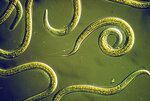Nematodes are everywhere!
They are the most abundant multicellular animals on earth, with more than 80,000 known species. They are microscopic, elongated roundworms that occur naturally in soil …
This item is available in full to subscribers.
We have recently launched a new and improved website. To continue reading, you will need to either log into your subscriber account, or purchase a new subscription.
If you had an active account on our previous website, then you have an account here. Simply reset your password to regain access to your account.
If you did not have an account on our previous website, but are a current print subscriber, click here to set up your website account.
Otherwise, click here to view your options for subscribing.
* Having trouble? Call our circulation department at 360-385-2900, or email our support.
Please log in to continue |
|


Nematodes are everywhere!
They are the most abundant multicellular animals on earth, with more than 80,000 known species. They are microscopic, elongated roundworms that occur naturally in soil and plant root tissues.
Most nematodes are considered beneficial to the soil. They help break down organic matter, releasing nutrients that become available to plants. Some nematodes are “entomopathogenic” — they attack soil-dwelling insects, but do not damage plants, animals, birds, earthworms, amphibians, or people. Beneficial nematodes are commercially available, and can be an effective biological control in gardens, lawns, orchards, vineyards, or greenhouses.
“It’s a great thing for gardeners to be aware of, and a great alternative to chemical pesticides,” says Richard Lewis, consulting entomologist for WSU Extension. “Soil insect pests are common and very difficult to address using any kind of control measure. Beneficial nematodes can target specific soil pest problems, and they can also be used preventatively.”
In the early 1900s, beneficial nematodes were broadly used to control soil-borne pests, with some success. Synthetic pesticides were developed in the 1940s and ‘50s, and their use became widespread. In light of the harmful effects of broad spectrum chemical pesticides and recent technological advances, there has been a resurgence of interest in beneficial nematodes.
Richard explains that modern genetic analysis allows scientists to better identify specific nematode species and match them to their target pests. Better methods of storing and delivering nematodes to gardeners has also helped increase their effectiveness.
There are two main families of beneficial nematodes, Heterohabditadae and Steinernematidae. Both contain several species that target certain insects. Heterorhabditis bacteriophora (Hb) is a natural enemy of cutworms, grubs and larvae of root borers, root weevils, and flea beetles, as well as other pests commonly found in lawns and gardens. These nematodes can also be effective against wireworms that typically target potatoes and carrots. Hb nematodes move vertically through the soil to attack their pests and are able to travel deep down, a clear advantage compared to most chemical pesticides.
Steinernema feltiae (Sf) targets insects that feed near the soil surface or inside plants, such as flea larvae, ants, rust flies, root aphids, or ticks.
“Many suppliers are developing a mixed batch of species from both families – a variety pack – so gardeners can cover more bases,” advises Richard.
Nematodes are prolific and persistent. Once introduced to the soil, they can persist for months or even years.
“If a pest is there, they’ll find it,” says Richard. “Beneficial nematodes have huge biological potential — 100,000 individuals can emerge from a single host.”
“They have become more user-friendly,” he continues. “You don’t need any personal protection gear or application equipment other than a watering can.”
Nematodes can be delivered in a variety of ways including polyurethane sponges, water-dispersible granules, vermiculite, or alginate gels that can simply be dropped into a watering can or applied using a standard hose sprayer.
Nematodes are sensitive to ultraviolet light and desiccation, so it’s critical to follow directions carefully and apply them to moist, well-drained soil in early morning or early evening. Ideally, soil temperature is between 55° to 91°F, covering most of the year in our region.
The nematodes depend on water-filled pores between soil particles to find their hosts, so moist soil rich in organic matter is preferred. They are less effective in dry or clay soils, or soil that has been treated with herbicides or pesticides.
Richard recommends focusing on a few key areas to experiment. “The only possible downside is cost, but compared to the cost of chemical treatments and plant damage, it can be a good investment.”
As an example, 5 million Hb nematodes can be purchased for about $30 to $40. Depending on the specific product, that might cover 250 to 1,000 square feet.
Nematodes can be applied in the spring as a preventative application or during the growing season to directly target a pest problem. It’s important not to overdo it — applications once or twice a year are enough.
Knowing the target pest’s lifecycle is key to finding the best window of opportunity. Typically, nematodes are most effective when the target is in its larval stage. The larvae in the soil, while adults are often terrestrial or aerial. As an example, cutworm larvae live in the soil or thatch layer, but the adult moths are usually flying around.
The nematodes inject the larvae with a symbiotic bacteria that multiplies in the host, killing it. The nematodes feed on the bacteria and reproduce inside the host, building up their population until resources run out. They then emerge en masse, each seeking a new host.
Only a small percentage of nematode species (about 15 percent) are plant-parasitic and harmful to crops, causing damage by feeding on roots. There is some evidence that beneficial nematodes can actually reduce the number of plant-parasitic nematodes in the soil, a possible added benefit to applying them.
It’s likely that beneficial nematodes are already present in healthy soil. Adding more of them can help solve current pest problems and potentially avoid future ones. Combine them with other good practices — like mulching, using compost, rotating crops, and planting cover crops — to promote an abundance and diversity of beneficial soil microorganisms in your garden.
While WSU Extension does not recommend commercial suppliers, information on beneficial nematodes can be found at online companies like Arbico Organics or Rincon Vitova.
(Barbara Faurot is a Jefferson County Master Gardener and Master Pruner, working with other volunteers who serve as community educators in gardening and environmental stewardship.)